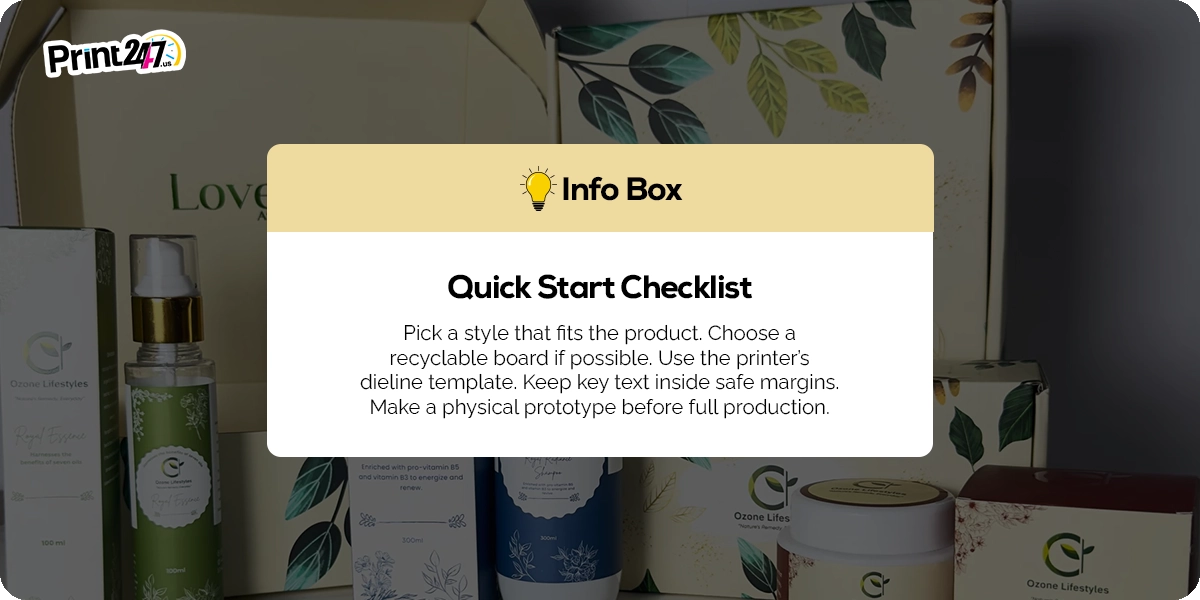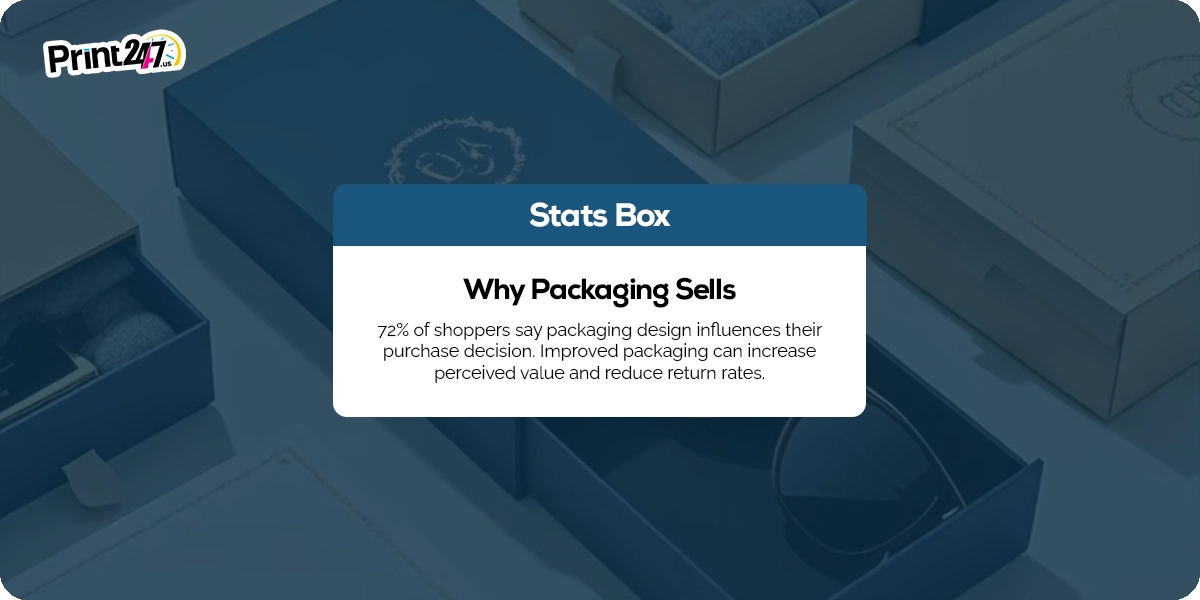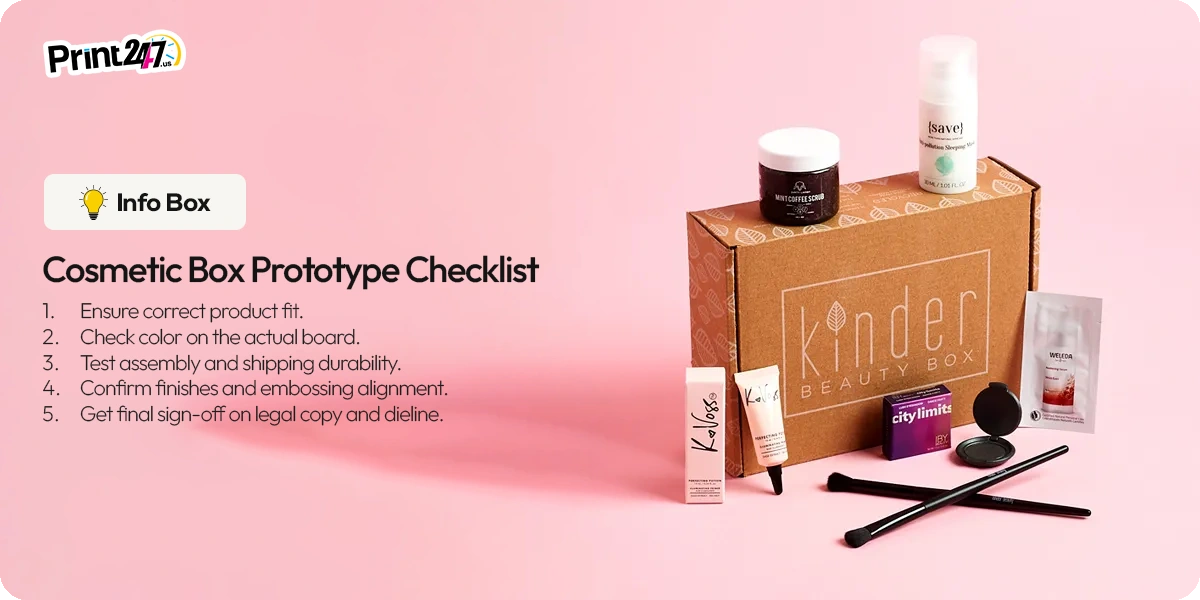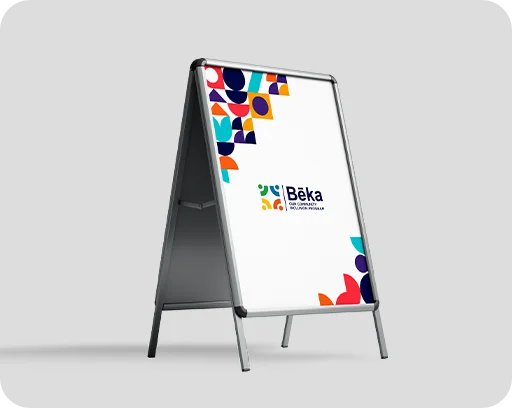From Concept to Shelf: The Complete Process of Designing Custom Cosmetic Boxes
.jpg)
Designing custom cosmetic boxes involves choosing the right style, selecting the right materials, creating a precise dieline, ensuring clear graphics, providing honest copy, and ensuring the finishes match your brand. Working with Print247 for final production, eco choices, and reliable delivery helps you test prototypes, check regulatory information, and ensure compliance.
When a customer engages with your beauty brand, the first thing they see is the packaging. When a product arrives in a safe, strong box, it helps consumers understand what they are buying and why they should care. In addition to looking good, a good cosmetic package feels good and is easy to use. That matters whether you sell face cream at a boutique or a serum online.
We’ve written this informative blog that breaks the whole process into clear steps. We’ll guide you on how to pick a box style that fits your item and how to choose materials that balance cost and quality. Furthermore, you’ll also learn how to prepare a dieline so the artwork lines up, and how to add finishes and copy that improve sales. You will also learn why prototypes are not optional.

Why Properly Designing Cosmetic Boxes Matters?
Packaging is not only about protecting the products. It sends a clear message to your customer. When your customers see your product box in a store or online, they have only a few seconds to judge your cosmetic product. A good box makes a product look trustworthy. A poorly designed box makes a product feel cheap.
Well-designed packaging also reduces returns and damage. If a perfume bottle moves around and breaks in shipping, that costs money and hurts your brand reputation. The right structure and inserts keep fragile items safe. Labels and copy on the box also serve a legal role. Ingredient lists, volume, and warnings are not optional. They must be clear and follow the rules for the country you sell in.
A well-designed box can give customers the ideal impression before they open it. That impression can create repeat buyers and social shares. People post unboxing videos when a package feels special. Thoughtful design turns a one-time purchase into a repeat buyer and an unpaid marketing moment.
Finally, materials and production choices matter for long-term brand health. Design must match your brand promise so customers do not feel misled.

(Source: Ipsos)
A Step-by-Step Approach to Designing Cosmetic Packaging for Success
When it comes to designing great packaging, it all starts with a clear idea of who will buy the product and how they will use it. Every choice should solve a specific problem: protecting an item, communicating a brand, and making the product easy to use.

Below are practical steps to follow from the first style choice to the final sign-off.
Step #1: Choosing the Right Box Style and Structure
Box style affects cost, protection, and the way the product is presented.
For example:
Folding cartons are common for storing lotions and small items. Why? Because they are light, printable on all sides, and cost-effective for medium runs.
On the other hand, rigid boxes feel heavier and more luxurious. They are common for high-end creams and gift sets. Tuck end boxes are simple and quick, ideal for single items that need a fast turn.
Sleeve-and-tray combinations create a reveal effect that works well for sets and gifts. Window boxes show the product, which can help with visually appealing items, but windows can complicate recycling.
Step #2: Selecting the Perfect Material
Materials selection is a critical step in designing custom cosmetic packaging. It influences the look, strength, and recyclable nature of your box.
Here are some cosmetic packaging materials choices:
Paperboard is the most common material for cosmetics. It comes in several grades.
SBS, or solid bleached sulfate, gives a smooth white surface and prints brightly.
CCNB has a white or coated front and a recycled back. It is more economical but still prints well.
Kraft board has a natural brown look that fits eco or minimalist brands.
Corrugated board is for heavy items or outer boxes to protect shipments. It’s highly recyclable, which attracts eco-conscious customers in great numbers. Due to its lightweight nature and cushioning benefit, it creates unique experiences for your customers.
Board weight is important. Higher-gsm paper makes stronger, more protective boxes. It is typical for high-end boxes to be made from paper that weighs between 300 and 600 grams. You may be able to make lighter products with 230 to 300 gsm. Boards with a thicker thickness cost more, but they provide better protection and feel more luxurious.
Step #3: Understanding and Creating Your Dieline
A dieline is the flat template that shows where cuts, folds, and glue go. It is the blueprint that makes a printed sheet become a real box. Creating a perfect and accurate dieline is an essential step in the process of designing a custom cosmetic box
Here’s how you can create a dieline for designing packaging for cosmetics.
Start with exact product measurements, including any inner insert or pouch. Build the dieline in vector software with clear layers for cut lines, fold lines, and bleed. Bleed is extra artwork that extends beyond the trim line. A typical bleed is 3 mm.
Place all important text and logos inside a safe margin so they are not too close to folds or trim.
Mock up the dieline early. Print a paper prototype and fold it to check alignment. A small shift in artwork can hide a logo in a fold or split a line of copy across the wrong edge.
Make adjustments before you send files to press. A clean dieline and a clear file package save time and cost at the production stage.
Step #4: Crafting the Visual and Graphic Design
Visual design on high-end cosmetic packaging tells the product story in seconds. Color, type, images, and layout all help a buyer understand what the product does and who it is for.
For beauty products, color choice is a strong signal.
Pastel tones often suggest gentle or natural skin care.
Strong jewel tones can indicate higher price points and a more dramatic effect.
Neutral palettes and clean lines often suggest minimal or clinical products.
Type choices matter for clarity and tone. A clear hierarchy helps scanning: brand name, product name, key benefit, then supporting bullets.
Imagery should be sharp and simple. Logos should be vector-based so they scale sharp on print and at different sizes.
Step #5: Enhancing Your Design with Premium Finishes
Finishes let you raise perceived value without changing core packaging structure. Cosmetic packaging finishes affect both look and feel.
Here’s how each lamination gives your beauty product packaging a premium feel:
Matte laminates provide a smooth surface that resists fingerprints.
The glossy laminate makes colors pop and feels smooth to the touch.
Velvet-like coatings lend a luxurious feel.
Using foil stamping brings metallic highlights to the design.
An embossed surface adds a touch of tactile appeal.
To add contrast to matte areas, spot UV creates glossy accents.
You should consider how the finishes work together when choosing finishes. Also, check how finishes affect color and registration in printing. Some effects require precise alignment, which may add time and cost to production.
Finally, consider cost and lead time. Complex beauty packaging finishes often add to both. If speed to market matters, choose simple laminations and one or two finishing touches rather than multiple complex effects.
Step #6: Prototyping and Final Approval
A packaging prototype turns designs into reality. It shows how the dieline folds, how finishes look on the actual board, and whether the product fits with any insert. It is always recommended to see the physical sample.
Here’s how to proceed for this step in the overall custom cosmetic packaging design process:
Start with a simple structural mockup printed on plain paper to test fit.
Then move to a full-color prototype on the chosen board with the intended finish.
Test the prototype in real use.
Put the product in and out of the box several times.
Drop test the package lightly to see how it handles.
In order for the final approval of the project to proceed, it's necessary to sign off on dielines, print-ready files, finishing specs, and proof of material certification if you're claiming sustainable content in the project. The revision log should be kept so that everyone knows which version is the final version. In addition to reducing waste, a careful prototype process keeps production on track.

Where to Buy Eye-Catching Cosmetic Boxes in 2025?
Choosing the right manufacturer is as important as the design. A reliable beauty boxes supplier helps fix problems early and guides material choices, finishing options, and lead times.
Print247 is a full-service company that provides dieline support, free design help in many cases, and a sample and prototype program. We offer eco-friendly cosmetic packaging materials and can guide choices between digital and offset printing depending on volume and timeline.
We also provide guidance on finishes and regulatory copy placement. An experienced packaging supplier can assist you throughout the entire process, which reduces stress and the likelihood of costly mistakes.
FAQs
How to design cosmetics packaging?
The first step in designing an effective cosmetic package is to take the time to get to know your target audience and brand persona. Your story should be told through your choice of colors, fonts, and materials. You must make sure the design is practical, as it must protect the product and also be simple to use.
What makes cosmetic packaging attractive?
The colors and font that are cleverly combined, as is the layout, make the cosmetic packaging attractive. You should be able to feel the packaging just as much as it looks in your hand. You should be able to feel the packaging just as much as it looks in your hand.
What is the popular box design for cosmetic packaging?
Minimalist designs are very popular. Simple tuck-end boxes are a go-to classic. You'll also see many two-piece boxes with a separate lid and sleeve boxes, which add a nice little unboxing reveal for the customer.
How to make my cosmetic box look expensive?
Focus on the details and the feel. It is recommended to use paper stock that is thicker and of higher quality. You can add a special touch by embossing logos, using metallic foil, or using a soft-touch matte finish. In most situations, a simple, clean design enhances the appearance of luxury.


















































.jpg)
.jpg)
.jpg)